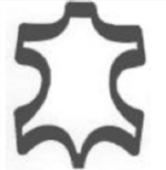On 19th January 2013 the Court of Milan ruled in Chaussures Eram SARL v Unic Servizi Srl. The court concluded that collective or certification trademark applications must, among other requirements, contain a novel element.
As a consequence, it declared the nullity of the collective mark consisting of a symbol portraying stylised animal skin. The trademark was well known in Italy as “vacchetta” ("little cow"), and was registered in Classes 16, 18, 21, 25 and 28, claiming goods made of leather in each class. The court held that such a sign became generic before the date of filing the trademark application (7th April 1977), and was also affected by subsequent unlawfulness.

Lawsuit
On December 2009 Eram commenced an action against Unic, the Italian national association of the tanning industry. Eram claimed that several collective marks owned by Unic, which consist of the image of stylised animal skin, registered either alone or together with the expressions “vera pelle" or “vero cuoio" (“genuine animal skin” or "genuine leather”), should be declared null.
Eram sought the declaration of nullity for several reasons, including the following:
-
The device part of the trademarks was perceived as generic by consumers before the filing of the relevant applications.
-
Alternatively, the device part became generic after the filing.
-
Unic did not control the use of the contested marks, as required for collective or
certification trademarks.
-
Unic’s actions violated Italian antitrust laws.
Stylised cow skin is generic
To date, the Court of Milan has ruled only on the question of whether the device parts of the trademarks were generic from the start, or alternatively became generic. The court has also commented on antitrust issues. The case is continuing with respect to the remaining trademark claims. The court stated that collective marks are subject to a requirement of novelty.
A sign which became generic before the application date could not be validly registered as a collective mark. The court noted that otherwise, a subsequent collective mark would render illegal the general use of the sign. In so doing, the collective mark would betray its statutory function, which primarily serves to ensure consumers of the quality of a product or service.
The court also stated that the requirement of novelty can be met when – together with a generic sign – the collective mark also includes additional elements suitable to confer to the overall graphic composition a certain distinctive character. Such additional elements may even be descriptive, provided that the particular combination of words and device is distinctive.
The court concluded that the plaintiff had proved, through numerous documents, the widespread use of the image of the relevant stylised animal skin in France since 1925, in Germany since 1973, in England since 1968 and in the United States since 1961. This evidence clearly demonstrated the generic nature of the image.
The 1994 directive
In addition, the court noted that the European Union, in regulating matters concerning the production of leather goods, had made specific reference to the contested sign further confirming the generic nature of the stylised animal skin symbol.
Directive 94/2011/EC on the approximation of the laws of the member states relating to the labelling of the material used in the main components for footwear introduced the duty of describing the materials used to produce footwear. It regulated the use on footwear of labels containing symbols suitable for identifying the materials with which parts of footwear are made. According to Annex 1 of the directive, the symbol which should be used for identifying leather goods is the same as the sign represented in the contested mark (ie, the figure of a stylised cow skin).
The court not only concluded that such a sign represents a graphic element largely used in the European Union before the time of the trademark applications, but also noted that the scope pursued by the directive appeared to be incompatible with the monopoly that Unic attempted to enjoy in Italy through the control of collective or certification trademarks. The court thus stated that the contested trademark was invalid not only for originally lacking novelty, but also for reasons of nullity which emerged after registration.
Collective trademarks including words in addition to generic device may be valid
The court went on to distinguish between Unic’s trademarks consisting of the cow skin device alone, and Unic’s trademarks which also include the words "vera pelle" and "vero cuoio". The court stated that the combination of the device with these words could create a valid trademark, or at least a trademark which was not generic despite the rather descriptive nature of the words. A decision is still pending as to whether the lack of quality control by Unic rendered the composite trademark null due to improper use.
While recognising the potential validity of trademarks which include both a device and words, the court nevertheless limited the trademark rights of Unic. Unic will not be permitted to enforce these trademarks against third parties which use the figure of stylised animal skin, together with indications such as "cuoio" (leather) or "pelle" (skin) in the event that the overall graphical impression of the trademarks used by third parties was different from Unic’s.
Comment
The Court of Milan judgment, although partial and still pending on some issues, al- ready has important legal and practical implications. The most important consequence is that the judgment rectified an Italian anomaly re- lating to the use of the “vacchetta” device. Before the decision, the contested mark was freely used by the tanning community in other countries of the European Union.
In Italy, however, Unic enjoyed a unique monopoly, and frequently asked for and obtained the seizure of goods based on its trademark rights. Such a situation created significant uncertainty for foreign tanning companies operating in Italy. Now, provided that the decision becomes final, this anomaly will end, since the judgment liberalised the use of the “vacchetta” device alone, and also significantly restricted Unic’s exclusive rights on collective trademarks consisting of the device together with the words “vero cuoio” or “vera pelle”.
The decision also has implications beyond the “vacchetta” device, as it confirms that the requirement of novelty should be strictly assessed when applied to collective or certification trademarks.





